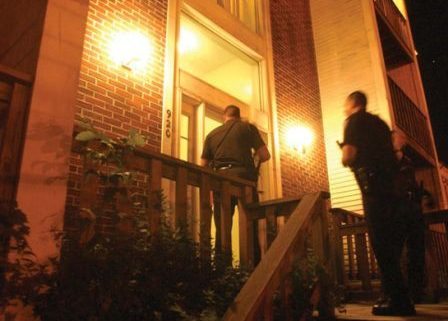It was a Saturday morning, a day when the temperature had already reached the mid 90s and the southern air with was tightly packed with enough humidity to make it appear as if a quick rain shower had passed through. The air was so thick, in fact, that rednecks switched their pickups and jeeps over to four-wheel-drive to help plow their way to the liquor stores where they purchased ice cold PBR beer, fifths of Jack, and fistfuls of lottery tickets.
Condensation on the windows of the county jail, the red brick building that also housed our offices, was dense enough to obscure the view outside. The only means of seeing any sign of life on the outside was when a drop of water wriggled its way down the glass, leaving a temporary translucent trail in its wake. The situation frustrated the inmates who, as always, hoped to catch glimpses of female passersby so they send out obnoxious catcalls, whistles, and inappropriate comments about their desires for a quick hands-on anatomy lesson.
The trash talk didn’t faze these women, though, because they were a handful of professional teasers who enjoyed sending the incarcerated men into what my grandmother would’ve called a “tizzy.” Those women drove the prisoners into such a state that had the floors not been made of steel reinforced concrete they’d have rutted holes in them much like wild hogs plow through collard and turnip patches.
The painted ladies wearing short skirts and micro shorts and platform shoes and spiked heels with hairdos that were tall and big and caked with enough hairspray to hold in place a bumper on a ’49 “Shoebox Ford,” well, they simply drove the men KRAZY! Crazy with a “K,”by the way, is crazier than the “C” kind of nutty.
Even our brown patrol cars perspired. Moisture dripped from the leaves of the tall oaks that had lived on the courthouse lawn since the days of the Civil War. In fact, one of those trees served as the “hanging tree” back in the day. Jail inmates sat in their cells wearing nothing but sweat-soaked boxer shorts and white socks. The day was indeed on track to be a real scorcher.
I know, never start a story with the weather, but this is real life, not fiction. I’m not writing that first line, the hook, to grab your attention. I mentioned the heat and humidity because, as is with most instances involving police, it’s important that you know that temperatures and weather conditions often play a huge role in their profession.
It’s also important that each and every word in your tales has meaning and that each one has a purpose. For me, based on personal experience, weather can be “a character” in a story and it’s sometimes as important as the hero, the villain, or the victim. I say this because …
Words Melt Everyone
“Man it’s a hot one
Like seven inches from the midday sun
Well I hear you whisper and the words melt everyone
But you stay so cool” ~ “Smooth” by Santana, featuring Rob Thomas
Weather conditions are part of the equation, just as are criminals, courts, judges, and guns, including being a part of the smallest of details of a murder scene. Winter, spring, summer, fall, snow, sun, rain, and wind all play a role in the real world of cops and robbers. It has purpose and it has meaning.
Such as the mid August day in Savannah, Ga. when heat and humidity make you practically gasp for every breath like it could be your last, and when bending over to have a look at a victim’s body at the precise moment when that lone drop of sweat reaches the tip of your nose and you absolutely must prevent its fall to stop your DNA from commingling with that of the killer.
Or when preparing to enter an abandoned warehouse to search for the armed robber who was last seen going inside. It’s 10 degrees outside and the grip of your gun is ice-cold to the touch. Your hands are nearly numb and you can’t feel your toes because you’re standing in three feet of freshly-fallen Boston snow (Snow is Boston is colder than snow in other places we’ve lived. That’s a fact. I’m sure it’s written in a book somewhere.).
The combination of fear, frigid temperatures, and freezing digits cause your hands to tremble ever so slightly. Will you be able to shoot straight and accurately if the time comes and if your very life depends upon that first shot? Will the shaking and shivering if your body and clattering of your chattering teeth give away your position?
The wind howls outside, concealing the sounds of a bad guy’s movements. Is he in front of you to the side or to the rear? You don’t know because the only thing you hear is the sound of your own heart thumping wildly against the inside of your chest wall. That and the limbs of the old hackberry tree scratching and scraping across the weathered clapboard siding with each gust of swirling air.
So yes, weather is an important aspect of police work.
Saturdays are for Fishing, Not Killing
There were only two of us assigned to patrol the county that hot day, which was not a big deal because Saturdays were typically slow. Weekend nights were the times when the action jumped off. I suppose that most trouble-makers’ daytimes were reserved for rest, fishing, lawn mowing, recuperating from hangovers, and driving out to the back forty to plink a few rounds at tin cans and discarded refrigerators and rusty clothes washers. Fun times.
Some folks visited community swimming pools and a few teens would head out to the old gravel pit to swill cheap beer and to smoke weed and for a dip in the cool water. It’a place where at least one kid drowned each summer and usually within the next day or two we’d find the bloated body tangled in the branches of fallen trees, if a state police diver wasn’t able to immediately locate the victim in the incredibly deep water.
Sometimes we’d interview a sobbing 15- or 16-year-old girl who reeked of stale beer and pot smoke, a doe-eyed kid who’d stand on the ledge and weep and point to where she last saw him, right after she’d begged him to not leap of into the water from the rocky cliff. He’s a good swimmer, she’d say, but we’d been drinking and his buddies dared him to do it. So he did. Of course, she wouldn’t notice that her top was on backward or that her shorts were on inside out.
The 911 Call
My fellow deputy and I began our shift at 0800 that Saturday and we’d decided to catch up on a bit of paperwork at the office before going our separate ways, making ourselves seen throughout the county. Nothing much happened before noon on Saturdays anyway.
It was 9:30 when a man called the dispatcher to say he’d just killed his sister-in-law and that the “911 lady” should send “the Po-leece” right away. Then he hung up.
So we each sprinted to our patrol cars and left the front of the jail with red and blue lights winking, spinning, and blinking. Throughout the city streets we blasted our sirens at intersections and when we drove up behind the Saturday morning Q-tips who were in town to do their weekly shopping—the older ladies of a certain age to get their hair styled and molded into those blueish helmet shapes, and the men who stopped in the barbershops for a snip here and there and to have the barber apply enough tonic to keep the combover in place while they visited the feed store to browse through the rows of shiny red or green mowers and tractors. Then, when enough time passed the tractor-lookers would toss their canes into the backseats of their Ramblers or Buicks and head back over to Betty’s Cut and Curl to pick up the wife so together they could do their grocery shopping and perhaps have a bite to eat at the diner (two for one on Senior Saturday) before traveling at a snail’s pace back to the farm.
They were slow drivers who never, not ever, looked into their rearview mirrors. So we’d follow behind with full lights and sirens until we caught a break in traffic so we could pass.
This day, though, we pushed the limit, zipping through town until we reached the main county road that led us in the direction of the alleged murder. The location was 30-40 minutes away when driving the speed limit. We reached scene in less than 20. As the truckers’ used to say, it was pedal to the metal all the way. We straightened curves by taking advantage of “the racing line” of the roadway.
For those of you who don’t know, a driver who follows a racing line greatly reduces the angle of a curve by entering it at a the far outside edge of the roadway and then crosses over to the inside edge, the apex. The apex is the point at which you are closest to the inside of the corner. The technique is completed by moving back to the far outside edge of the roadway. This maneuver is sometimes called “hitting the apexes.” It reduces braking and “straightens the curve” which allows the officer to drive safely through curves at a much faster speed. However, it is a must to constantly remain alert for oncoming traffic since some of the officers’ curve-straightening involves driving on the opposite side of the road.
Standing beside a mailbox at the end of a long dirt drive was a man dressed in a red and white striped shirt, white pants, and brown work boots. As we turned into the driveway I noticed what appeared to be a significant amount of blood spatter on his clothing and shoes, so I stopped. He was obviously agitated, excited, and he rambled on incessantly about that fact that he’d just arrived to earth from Mars. I handcuffed him, placed him in the seat beside me (we didn’t have rear cages), and hurried to the house.
My coworker and I raced to the door and went inside, yelling “Sheriff’s Department!”
What we found in the home, in the master bedroom, was nothing short of the stuff horror movies are made of.
Blood oozed down the painted drywall in narrow but rapidly drying convoluted trails. Dots and globs of patter of various sizes and shapes were everywhere—ceiling, walls, the floor.
A severed human hand lay next to one wall. I’d later count 13 chop marks in the hardwood next to it. Pools of rusty-red blood separated by drag marks of the same color and substance led to the body of a dead woman, a female who died a brutal death caused by the repeated blows of an ax.
The woman’s forearms were badly cut, signs that she’d attempted to stop dozens of strikes of the ax. A large gash to the right side of her head revealed the white of her skull, bone that had been hacked and chipped away, exposing brain matter. Some of which was found stuck to the ceiling and walls and scattered along the hardwood floor along with mall bits of splintered bone were scattered across the floor.
Looking back at scenes such as this one I often wonder about the former function of those bits of brain found adhered to various surfaces. Were there someone’s memories clinging to lampshades? Reasoning abilities plastered on the screen if the family television? A grandmother’s recipe hanging from a picture frame?
At the scene I mentioned above, blood spatter was also on the furniture, including a king-size bed. It’s dull brownish-red hue was in sharp contrast to the crisp white sheets. More spatter was on the faces, hands, legs, feet, and kids’ pajamas worn by the woman’s four small children who sat huddled together on the center of the mattress. They’d witnessed the entire act, a murder that occurred for the simple reason that the killer had asked his sister-in-law for enough money to purchase a pack of cigarettes. She didn’t have it so the man walked outside to the woodpile where he picked up the ax and went back inside to kill her.
The first blow was from behind, to the head. We pieced together that at that point the woman went down but turned and held up her arms and hands to fend off the onslaught that followed.
When I questioned the killer, he claimed to have come to earth from Mars and that voices from a tower told him to kill the woman. He also said he’d cut off her hand because it kept pointing at him.
He’d been tucked away in a psychiatric care hospital until two weeks prior to the murder. His release came when a sympathetic judge found him competent to return to life outside, placing him in the care of his brother. Fourteen days later the brother’s wife was dead and his four kids were scarred for life.
The killer was found to be not competent to stand trial for the murder and has remained in an air-conditioned psychiatric facility since.
TOMORROW is the LAST DAY to sign up for a “Seat” at Virtual MurderCon’s interactive event, and only a few “seats” are available!
I urge you to sign up asap to reserve your spot at this unique opportunity, one that may never again be available. This is a live event, presented in realtime. Q&A is available at the end of each presentation. In addition, the final session is live panel and Q&A discussion with each of the experts. So have your questions ready, because this is the time to gather the extraordinary details that will make your book zing with realism.
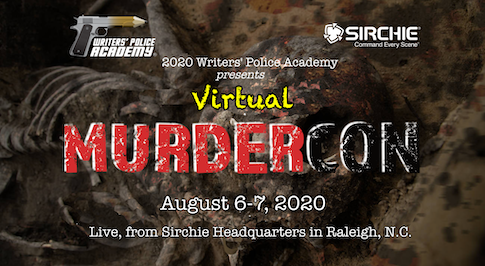
Registration to the Writers’ Police Academy special event, Virtual MurderCon, is scheduled to end at midnight, July, 31, 2020. However, registration will close when all spots are filled, and it certainly looks like the event will indeed sell out any day now.
Again, this is a rare opportunity for writers to participate in virtual, live and interactive, “for law enforcement eyes only” training.
This incredibly detailed, cutting-edge instruction has never before been available to writers, anywhere. Until now.
Virtual MurderCon Classes and Special Presentation
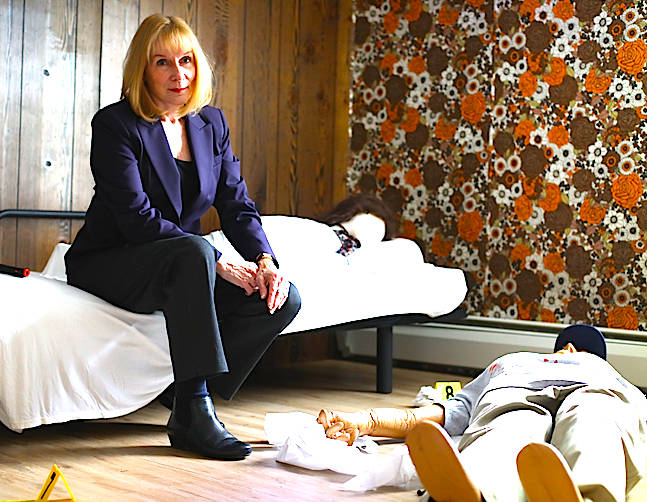
This fabulous, one-of-a-kind event opens with “How to Catch a Serial Killer,” a special presentation by Dr. Katherine Ramsland.
Katherine Ramsland is a professor of forensic psychology at DeSales University in Pennsylvania, where she also teaches criminal justice and serves as the assistant provost. She holds a master’s in forensic psychology from the John Jay College of Criminal Justice, a master’s in clinical psychology from Duquesne University, a master’s in criminal justice from DeSales University, and a Ph.D. in philosophy from Rutgers. She has been a therapist and a consultant. Dr. Ramsland has published over 1,000 articles and 66 books.
Dr. Ramsland’s background in forensics positioned her to assist former FBI profiler John Douglas on his book, The Cases that Haunt Us, to co-write a book with former FBI profiler, Gregg McCrary, The Unknown Darkness, to collaborate on A Voice for the Dead with attorney James E. Starrs on his exhumation projects, and to co-write a forensic textbook with renowned criminalist Henry C. Lee, The Real World of a Forensic Scientist.
For seven years, she contributed regularly to Court TV’s Crime Library, and now writes a column on investigative forensics for The Forensic Examiner and a column on character psychology for Sisters in Crime; offers trainings for law enforcement and attorneys; and speaks internationally about forensic psychology, forensic science, and serial murder.
Art of Blood – Violent crimes and accidents frequently involve the interpretation of blood evidence. This class includes presumptive testing techniques of stains thought to be blood, as well as searching crime scenes for latent blood with luminol when circumstances dictate that the area was cleaned by the perpetrator.
DNA evidence collection is also a part of this detailed session taught one of the top experts in the field.
Child Abduction/Murder – Taught by the investigator who solved the high-profile case that drew national attention, this presentation follows the evidence to tell the story and will graphically show the connections which solved the crime.This child abduction/murder case involves a 12 year old girl who was kidnapped at knife point from her bedroom while enjoying a sleepover with two of her friends.
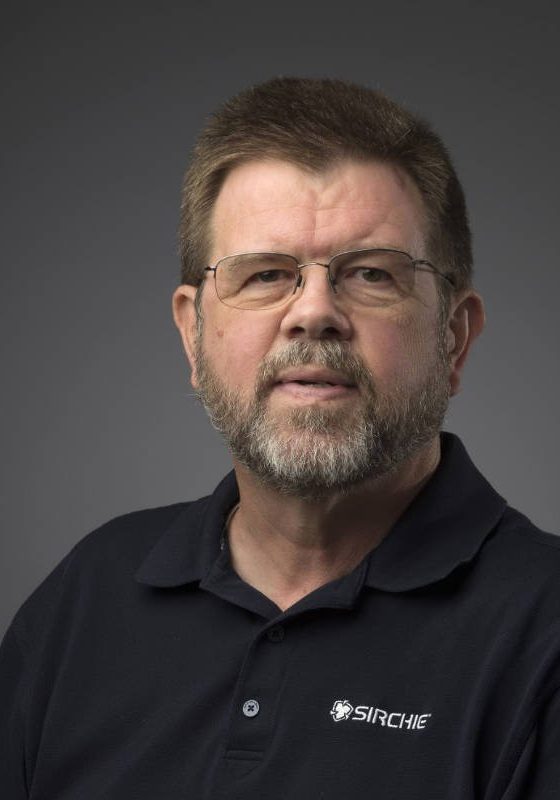
Instructor David Alford is a retired FBI Special Agent with 21 years of experience investigating violent crimes, terrorism and other cases. He was one of the founding members of the FBI Evidence Response Team (ERT) and conducted crimes scene searches on domestic and international violent crimes and bombings, including the Polly Klaas kidnaping and murder, the Unabomber’s cabin and the 9/11 Pentagon scene. He worked in the Denver and San Francisco field offices and completed his career at Quantico in the FBI Lab ERT Unit. During the 6 years in the FBI Lab, he was primarily responsible for overseeing and teaching basic and advanced crime scene courses throughout the US and many other countries.
In the 6 years before the FBI, David was a Forensic Serologist, Hair and Fibers Examiner and Bloodstain Pattern Analyst for the Kentucky State Police Crime Lab. After retirement, David taught crime scene courses around the world on behalf of the FBI and US State Department. David has been with Sirchie as an instructor and sales representative for Sirchie’s RUVIS and ALS products for the last 10 years. David loves teaching and allowing students to learn through hands-on training.
Drugs/Toxicology NARCAN By Noon – This session will explore drug trends and mortality of drug users, and how can they determine overdose versus foul play.

Instructor Sgt. James Yowell, a counter drug investigator who, as an undercover officer investigated international drug trafficking cases targeting Mexican organized crime.
Entomology: From The Inside Out– Bug and scavenger activity can tell a lot about a corpse. Using entomology and environmental information, a skilled investigator can determine relative time of death, if a corpse has been relocated, and many other key facts. Learn how nature works from the inside out.
 Instructor Dr. Bryan Brendley’s specific areas of focus are cell biology, botany, and forensic anthropology. He has conducted years of research on the impact of insects on decomposing bodies with his students. He teaches a comprehensive forensic science program.
Instructor Dr. Bryan Brendley’s specific areas of focus are cell biology, botany, and forensic anthropology. He has conducted years of research on the impact of insects on decomposing bodies with his students. He teaches a comprehensive forensic science program.
Fingerprinting: Who’s MARK – Attendees will receive instruction on developing impression evidence from dust utilizing a electrostatic dust print lifter, and on porous surfaces, including paper and cardboard utilizing chemical processes. Cyanoacrylate (“superglue”) techniques for non-porous surfaces will be addressed.

Instructor Jim Gocke is a graduate of West Virginia University and West Virginia College of Law. In addition, he completed a Fellowship in Forensic Medicine at the Armed Forces Institute of Pathology and earned a Master of Science in Forensic Sciences from The George Washington University. He was employed by Sirchie Fingerprint Laboratories, Inc as Vice President/General Counsel and Director of Education and Training from January 1979 until March 2008. He was employed by Sirchie Acquisition Company, LLC as Director of Education and Training from March 2008 until his retirement in July 2015. Currently, Jim serves as an Independent Contractor to Sirchie, providing expertise in Education and Training, product development and evaluation and technical assistance.
Footwear Evidence: A Step In The Wrong Direction – Similar to fingerprints, footwear has unique and probative characteristics that are often used to track down criminals. Learn the tactics, techniques, and the one-off physiognomies that help lead investigators to the source of a crime du jour.
Shoes, Glorious Shoes: Lifting Footwear Impressions – This fascinating session provides details of the various techniques utilized to process areas conducive to footwear evidence. Instructor Andy Parker demonstrates the electromagnetic dustprint lifter, gelatin lifters, and other CSI techniques.

Instructor Andy Parker has a Bachelor of Science degree in Criminology / Criminal Justice from Florida State University. He began his career in law enforcement with the Florida Department of Law Enforcement. After seven years with FDLE, he worked crime scenes, analyzed latent prints and footwear evidence for the Tallahassee Police Department. In 2002 he began work with the City-County Bureau of Identification in Raleigh NC. At CCBI, he has held the position of Latent Print Examiner, Latent Print Section Supervisor, Deputy Director in charge of the Identification Division, Deputy Director in charge of the Laboratory and currently is responsible for the Investigations Division. He is a certified Latent Print Examiner with the IAI. Andy is also a graduate of the FBI’s National Academy.
Forensic Geology: “Sedimental” Journey– Think rocks and soil are boring? Not when presented by one of the few forensic geologists in the country who has testified in murder trials about her examination of soil collected as evidence from murder scenes that linked killers to known locations. Certain to be one of the most unique and intriguing sessions at MurderCon 2020, this session conducted by Heather Hanna will intrigue and inform attendees about the role of a geologist in mapping different soils throughout the United States—and a global level—and how forensic geology can prove useful as a foundation for comparison soil evidence in criminal investigations.
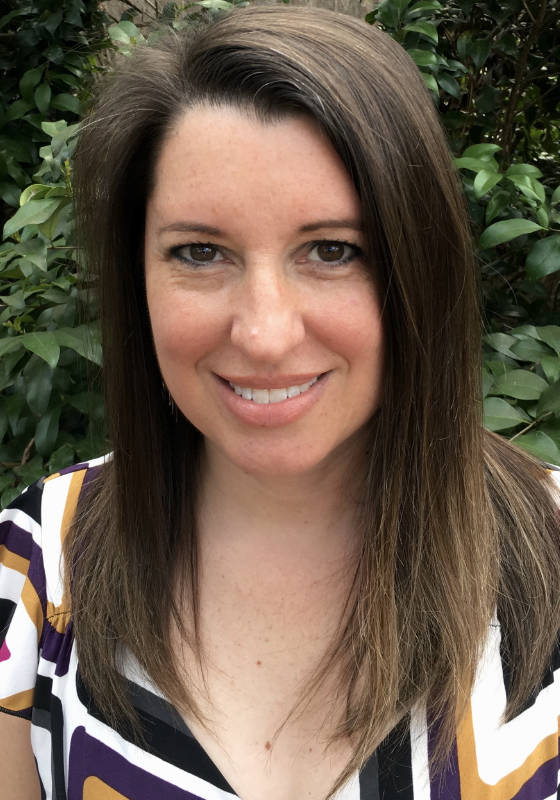
Instructor Heather Hanna is a forensic geologist specializing in the analysis of rock fragments and mineral grains in soils as trace evidence. Since 2009, she has been involved in multiple forensic investigations and has testified as an expert witness in four first degree murder trials, the first of which set a legal precedent in Wake County for using geochemical analysis of mineral grains in court. As a result of her forensic work, she has been an invited speaker at many law enforcement conferences and continuing education programs including the Conference of District Attorneys, the North Carolina Criminal Information Exchange Network, the North Carolina Homicide Investigators Association, and the North Carolina International Association for Identification. She has also presented her forensic work at national and sectional Geological Society of America meetings and as an invited speaker for the Soils Science Society of North Carolina.
Gazing Into The Cloud – No one is anonymous. Your digital footprint is wide spread and mostly out of your control. The Cloud is an ominous vapor of data that can haunt the most cautious criminal or victimize most innocent of people. What can be found in the cloud? Learn how easy it is to mine the cloud and use this data for good as well as nefarious activity.

Instructor Stephen Pearson combines more than 29 years of law-enforcement experience with in-depth expertise in today’s most pervasive Internet, computer, and digital device technologies. Stephen developed computer forensic tools and coursework for the US Army Military Police School, as well as served as a computer investigator with Pulaski County Sheriff’s Office (FL). As a founder of High Tech Crime Institute, he has developed and conducted courses for NATO, the Federal Government, and various law enforcement agencies. Stephen holds a B.S. in Computer Information Science as well as an MBA. He is also a Microsoft Certified Systems Engineer, an US Army Master Instructor, and a certified Cellebrite Trainer, in addition to holding various other certifications for digital investigation.
Homocide Or Homicide: You Decide – Have you ever wanted to spend time picking the brain of an experienced homicide detective? Well, here’s your chance. Having investigated a wide variety of murders, attendees will find this session fascinating in content due to the breadth and depth of homicides that will be discussed. Included in the “new” topic will be the discussion of why the United States suffers from over 200,000 unsolved murders. These “cold case” murders rarely get examined or investigated once they are “put to bed” due to a wide variety of causes and reasons. Learn from one of the best detectives around who has investigated several hundred murders!
Murder Case Studies – In this intriguing and highly-detailed workshop, Detective Jeff Locklear takes attendees on a behind the scenes journey into actual murder scenes. Learn the investigatory tools and tricks of the trade used by a top homicide detective as he sought and captured brutal killers.
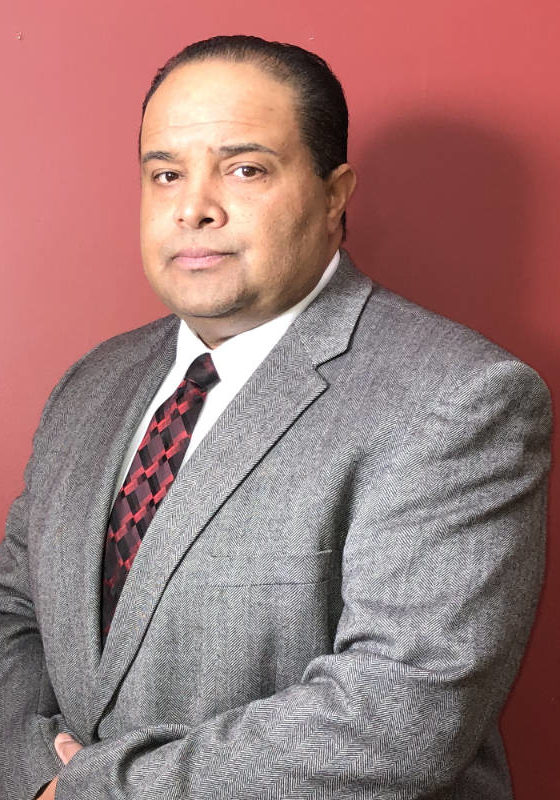
Instructor Detective Sergeant Jeff Locklear, a 21-year veteran law enforcement officer, currently works with the Fayetteville North Carolina Police Department as a homicide police specialist and training officer.
As a homicide detective he’s been involved with over 350 homicide investigations. He’s also investigated hundreds of violent felonies including rapes, robberies, aggravated assaults, and missing persons.
During his career he has responded to hundreds to death scenes such as suicides, homicides, accidental deaths, and natural and unexplained deaths.
Detective Locklear has conducted thousands of interviews of violent offenders, including cases featured on 48 hrs (The Kelli Bourdeaux murder), Swamp Murders, NCIS – The Cases They Can’t Forget: The Holley Wimunc Murder, Scorned Love Kills 2014, The Today Show, and numerous other news and media outlets, such as People Magazine and Time Magazine.
He’s a founding member of both the 2008 Fayetteville Police Homicide Squad and the 2016 Fayetteville Police Violent Criminal Apprehension Team (VCAT). In addition, he’s served as sheriff’s deputy , Forensic Technician, Patrol officer , Crimes against persons detective, homicide detective, gun and gang task force detective, and as a Violent Criminal Apprehension Team Detective.
Detective Locklear has presented cases workshops at a number of conferences and events, including the North Carolina Homicide Investigators Conference, North & South Carolina Arson Investigators Conference , Fayetteville State University (Criminal Justice), Fayetteville Technical Community College (Registered Nursing students), Methodist University, and more.
Having spent the majority of his career investigating violent crimes, Detective Locklear has a unique and vast perspective of being the first officer on scene, the Forensic technician processing the scene, the detective investigating the crime, and the detective whose task it is to track down and capture the suspects who committed the crimes. He’s a dynamic speaker who can “escort you” to a crime scene, “walk you” through what happened, “show you” who did it, and then “lead you” to where the suspect fled after committing the offense.
Murder-Mayhem -Session covers Cause, Manner, and Mechanisms of death, Coroner vs. Medical Examiner systems, differences in legal terminology for murder, homicide, and manslaughter, as well as, the realities in death investigations that are equivocal in nature. Physical, testimonial, and circumstantial evidence as introduced into the courtroom will be applied to death investigations. A case study of a very unique and rarely scene murder by hanging, and the forensic evidence obtained from the physical autopsy will be presented. This presentation includes a discussion of psychological autopsies and when they are utilized in criminal investigations.
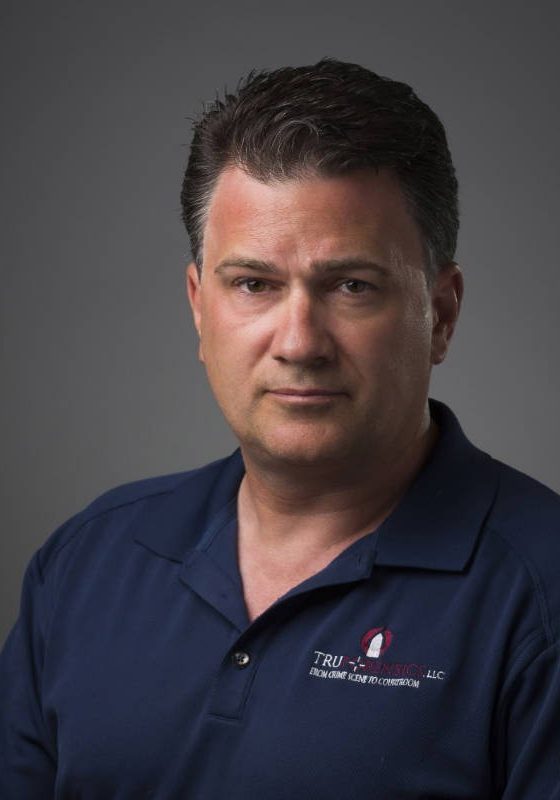 Instructor David Pauly retired from The U.S. Army Criminal Investigation Command as a Special Agent-in-Charge/Commander and Forensic Science Officer. He performed duties in over a dozen states, and frequently worked with local, state, and federal agencies. He also performed duties in Panama, South Korea, Afghanistan, Haiti, Kuwait, Saudi Arabia, Israel, Turkey, Sinai, Egypt, Canada, Guam, and Nigeria. He holds a Master of Forensic Science degree from The George Washington University and is currently the Director of Applied Forensic Science at Methodist University, Fayetteville, NC.
Instructor David Pauly retired from The U.S. Army Criminal Investigation Command as a Special Agent-in-Charge/Commander and Forensic Science Officer. He performed duties in over a dozen states, and frequently worked with local, state, and federal agencies. He also performed duties in Panama, South Korea, Afghanistan, Haiti, Kuwait, Saudi Arabia, Israel, Turkey, Sinai, Egypt, Canada, Guam, and Nigeria. He holds a Master of Forensic Science degree from The George Washington University and is currently the Director of Applied Forensic Science at Methodist University, Fayetteville, NC.
David graduated the FBI National Academy (Session 195), Canadian Police College – Major Crimes Course, Miami-Dade Police Department – Bloodstain Interpretation Course, and National Fire Academy – Arson Investigation Course. He is a Fellow of The American Academy of Forensic Science, and is a current, or past member of the International Association of Identification, North Carolina Chapters of the IAI and FBINAA, International Association of Bloodstain Pattern Analysts, North Carolina Homicide Investigator’s Association, The Vidocq Society, American Investigative Society of Cold Cases (AISOCC), and various other professional law enforcement and/or forensic science associations.


